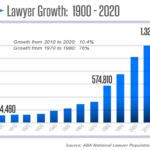In the first segment of this two-part article, we learned where attorneys are, how clients find attorneys, and how you can help clients find you faster. Now, in Part 2, we look at the most lucrative fields and geographic regions to practice law. We review how attorneys bill (including annual earnings), and how clients prefer to pay.
Again, special thanks to the 2020 ABA Profile of the Legal Profession and Clio’s 2020 Legal Trends Report for many of the statistics and data referenced here.
Legal Billing: How Lawyers Leave Money on the Table
Billable hours are king in the legal jungle, especially at the corporate level. We’ve all seen the movies, read the novels, and heard the jokes. Attorneys bill three different clients for the same hour. Because they’re under intense pressure from the top to maximize billings.
In the real world, however, it seems the converse is true. Recent statistics indicate that less than one-third of an attorney’s day (31%) is spent on billable activities. This means that 69% of your average day is taken up with non-billable work. Which is not revenue-producing time.
Two different sources suggest that attorneys leave 12% to 14% of their billing on the table. In other words, they are not paid for 12% to 14% of the hours they do bill to their clients. These ratios don’t mean you aren’t productive or dedicated or well-intentioned. They simply mean that you’re not reaping all the rewards for your efforts.
Top Earnings and Top Billable Rates
The U.S. Bureau of Labor Statistics’ 2019 Occupational Outlook Handbook indicated that the median annual wage for lawyers across the nation was $122,960. This median varies widely depending on geographic location and practice specialty.
The five states where lawyers earn top annual wages are led by the District of Columbia. The average attorney working in Washington, D.C. earns $197,100 per year in the seat of our federal government. They also charge the highest billable rate, at $380 per hour. Because they can.
California and New York follow in median annual wages at $179,470 and $174,060, respectively. Massachusetts and Connecticut rank 4th and 5th at $169,120 and $158,190 per annum.
By comparison, the median annual wage for attorneys in the state of Florida is $139,160. However, working in South Florida puts an additional $30,000 per year in your pocket. Attorneys in Miami, Fort Lauderdale, and West Palm Beach earn a median annual wage of $169,480.
The highest annual median wage in the country, in terms of metropolitan areas, is $231,610. This figure is earned by lawyers in California’s famed Silicon Valley—specifically San Jose, Sunnyvale, and Santa Clara. Tech giants ranging from Apple and Adobe to Google and Yahoo require high-powered lawyering and are willing to pay.
Top-Paying Fields of Practice
Nationwide, bankruptcy attorneys bill top dollar, at an average of $347 in hourly billing. Attorneys who work in juvenile law earn significantly less, billing an average of $88 per hour.
Five industries outperform the rest in terms of enabling lawyers to earn average wages in excess of $208,000 annually. What are they? Specialized design services (professional, scientific, technical) tops the list. The others are specialized equipment manufacturing (control, measuring, navigational, electromedical). Manufacturing of computers and peripheral equipment. The motion picture and video industries. And cable and other subscription programming. Patent and intellectual property law are in high demand in many of these industries, and pay well.
Legal Billing and Client Payment
That tells us a lot about attorneys. But what about their clients?
For starters, today’s consumers prefer to have some flexibility in paying their legal fees. Almost three-quarters (72%) prefer a payment plan to help spread the expense over time.
In addition, 65% of consumers prefer electronic forms of payment. They’d rather pay via credit card, debit card, or an online payment system like PayPal. No cash or checks, please.
In fact, 40% of consumers said they would not hire an attorney who didn’t accept credit or debit cards. Which is actually good news for attorneys. That’s because 57% of electronic payments to lawyers are paid the same day they are billed. 85% are paid within a week. It’s money in the bank, minus the usual collection headaches!
And for the 72% of clients who want a payment plan, most banks and card companies are able to set up automatic payments on a monthly basis. By being willing to accommodate clients in this manner, you can win additional business and referrals. Just be sure you bill and collect 100% of your fee. Get help from a legal support services firm to manage your legal billing and receivables, and stop leaving money on the table.

